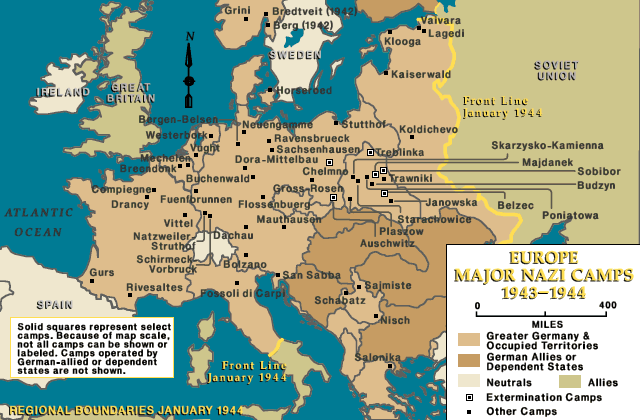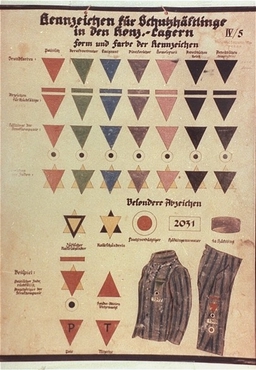
|
FREQUENTLY ASKED QUESTIONS
|
... About the Camps |
|
 |
|
1. Can you provide me with a list of the Nazi concentration camps? 
Since there were literally thousands of camps and subcamps established during the Nazi regime, it would be impossible to provide an all-inclusive list here. The following are the major camps and their locations, along with a map showing these camps and a few others:
Arbeitsdorf, Germany
Auschwitz/Birkenau, Poland
Belzec, Poland
Bergen-Belsen, Germany
Buchenwald, German
Chelmno, Poland
Dachau, Germany
Dora-Mittelbau, Germany
Flossenbürg, Germany
Gross-Rosen, Poland
Kaiserwald (Riga), Latvia
Klooga, Estonia
Majdanek, Poland
|
Mauthausen, Austria
Natzweiler-Struthof, France
Neuengamme, Germany
Plaszow, Poland
Ravensbrück, Germany
Sachsenhausen, Germany
Sobibor, Poland
Stutthof, Poland
Theresienstadt, Czech Republic
Treblinka, Poland
Vaivara, Latvia
Vught, The Netherlands
Westerbork, The Netherlands
|

A map of the major Nazi camps in Europe, 1943-1944.
— USHMM
|
To learn more about the Nazi concentration camp system, see the Holocaust Encyclopedia article "Nazi Camps," as well as the Museum Library's collection of Web links to online resources regarding individual camps.
2. What were the dimensions of the railway cars used to transport individuals to the Nazi camps? 
There were many different kinds of railway cars used for deportations, all varying in size and weight. The railway car on display in the Museum's permanent exhibit is of just one type used.
To give a sense of how the railway cars varied in size, we have provided the dimensions of the railway car on display along with the dimensions of the average freight car used for deportations in Hungary.
Dimensions of Railway Car on Display
- 31 ft. 6 in. in length
- 14 ft. high from the bottom of the wheel to the highest point of the car
- 13 ft. 2 in. wide (including the roofing)
- approximately 11 ft. wide inside the car
Dimensions of Hungarian Railway Car
- 26.8 ft. in length
- 7.2 ft. in width
Note for teachers: The Museum provides the dimensions of the railway car because of its significance as a historical artifact. However, please refer to the Museum's teacher guidelines for information about the dangers of simulating (based on a set of physical dimensions) the experience of deportation during the Holocaust. For a discussion of the dangers of classroom simulations and roleplays about the Holocaust, please see Guideline 12 in the Online Workshop for teachers or the printable resource Teaching about the Holocaust.
Source for Hungarian railway car dimensions: Randolph L. Braham, The Politics of Genocide: The Holocaust in Hungary, Volume 1 (New York: The Rosenthal Institute for Holocaust Studies, 1994), p. 686.
3. What did each of the identifying badges mean? 
The Nazis used triangular badges or patches to identify prisoners in the concentration camps. Different colored patches represented different groups. The colors and their meanings were:
| Yellow |
Jew |

A chart of prisoner markings.
— KZ Gedenkstaette Dachau
|
| Brown |
Gypsy |
| Violet |
Jehovah's Witness |
| Pink |
Homosexual |
| Green |
Habitual criminal |
| Red |
Political prisoner |
| Black |
Asocial |
| Blue |
Emigrant |
The "Asocial" category was, perhaps, the most diverse, including prostitutes, vagrants, murderers, thieves, lesbians, and those who violated laws prohibiting sexual intercourse between Aryans and Jews. In addition, while the brown triangle was used for gypsies under certain circumstances, they were more often forced to wear the black triangle categorizing them as "asocials."
Some patches included letters on the triangles to further distinguish among the various groups in the camps. Most commonly, the letter indicated nationality, e.g., "F" for franzosisch (French), "P" for polnisch (Polish), "T" for tschechisch (Czech), etc., but it could also denote special sub-categories of prisoners. For example, the white letter "A" on a black triangle signified a labor disciplinary prisoner (Arbeitserziehungshaftling), while a black "S" on a green triangle identified a strafthaft, or penal prisoner. In addition, the word Blod on a black triangle marked mentally impaired inmates, and a red and white target symbol set apart those who had tried to escape.
For Jewish offenders, triangles of two different colors were combined to create a six-pointed star, one triangle yellow to denote a Jew, the second triangle another color to denote the added offense. For example, a Jewish criminal would wear a yellow triangle overlaid by a green one; Jewish homosexuals wore pink triangles over yellow.
Outside the camps, the occupying Nazi forces ordered Jews to wear patches or armbands marked with the star of David, though the specific characteristics of the badge (size, shape, color) varied by region. For example, some yellow stars were marked with a large "J" in the center, while elsewhere the patches had "Jude" (or "Jood," "Juif," etc.) stitched in the middle. Those who failed to wear the star were subject to arrest and deportation, a fate that frightened most Jews into compliance even though the patch subjected them to restrictions, harassment, and isolation.
Source: Abraham J. Edelheit, and Hershel Edelheit, History of the Holocaust: A Handbook and Dictionary (Boulder, CO: Westview Press, 1994), pp. 218, 239, 266, 448.
For more information about the history of the requirement that Jews wear a distinctive marking or sign, including during the Nazi period, see the entry "Badge, Jewish" in the Encyclopaedia Judaica, Volume 4 (Jerusalem: Macmillan, 1972), pp. 62-73.
4. What Army units liberated the concentration camps? 

An American soldier and liberated prisoners of the Mauthausen concentration camp. Austria, May 1945.
— USHMM
|
The recognition of U.S. Army Divisions in World War II as "Liberator" units was an outgrowth of cooperation between the U.S. Army, the Center of Military History and the United States Holocaust Memorial Museum. In 1985 the United States Holocaust Memorial Council requested that the U.S. Army present its colors and those of the units that participated in the liberation of concentration camps for permanent display in the United States Holocaust Memorial Museum. At that time, ten liberating units were recognized based on information regarding only the major camps. Later, the inclusion of sub-camps increased the actual number of camps involved to over 5,000. This increase in recognized camps obviously increased the likelihood of liberation by American troops.
These facts, along with additional requests for inclusion by American veterans' organizations and individual veterans, led the U.S. Army to develop the following guidelines governing the recognition of liberating units:
- Evidentiary basis for a liberating unit must come from a primary source found in unit or other contemporary records. Oral history, testimony or secondary accounts cannot serve as the basis for recognition if they do not conform to primary source documents in official records.
- Recognition will go to the parent division of the respective lower-echelon unit (regiment, battalion, company or platoon).
- Recognition will not be limited to only the first division to reach a camp, but will include divisions that arrived at the same camp or camp complex within forty-eight hours of the initial division.
Neither the Museum nor the U.S. Army independently initiates the certification process. Instead, a division's liberation status is researched only after a divisional association asks for such recognition. The association must provide the name of the camp that it liberated, the approximate dates of liberation, the unit's geographical location at the time, and a brief account of the events. Then the information is researched using only official records at the National Archives' Washington National Records Center at Suitland, Maryland. Once a determination is made in favor of the "Liberator" status, a replica of the division flag is ordered from the Institute of Heraldry, and this flag is sent to the United States Holocaust Memorial Museum for display.
Source: Edward J. Drea, "Recognizing the Liberators: U.S. Army Divisions Enter the Concentration Camps," Army History 24 (1992/1993): 1-5.
The following divisions have been recognized as liberating units by the U.S. Army and the United States Holocaust Memorial Museum. Click on each division's name for a brief description of its activities during World War II. More information about this subject, including a list of Library resources for each division, can be found on the Library's bibliography "Liberators."
INFANTRY DIVISIONS
- 1st INFANTRY DIVISION
Liberated Falkenau an der Eger (Flossenbürg subcamp), May 7, 1945
- 2nd INFANTRY DIVISION
Liberated Leipzig-Schönefeld (Buchenwald subcamp), April 14, 1945 and Spergau (labor education camp), April 17, 1945
- 4th INFANTRY DIVISION
Liberated Dachau subcamps, April 28-29, 1945
- 8th INFANTRY DIVISION
Liberated Wöbbelin (Neuengamme subcamp), May 3, 1945
- 26th INFANTRY DIVISION
Liberated Gusen (Mauthausen subcamp), May 5, 1945
- 29th INFANTRY DIVISION
Liberated Dinslaken (civilian labor camp), April 3, 1945
- 36th INFANTRY DIVISION
Liberated Kaufering camps (Dachau subcamps), April 30, 1945
- 42nd INFANTRY DIVISION
Liberated Dachau, April 29, 1945
- 45th INFANTRY DIVISION
Liberated Dachau, April 29, 1945
- 63rd INFANTRY DIVISION
Liberated Kaufering camps (Dachau subcamps), April 29-30, 1945
- 65th INFANTRY DIVISION
Liberated Flossenbürg subcamp, April 20-21, 1945
- 69th INFANTRY DIVISION
Liberated Leipzig-Thekla (Buchenwald subcamp), April 19, 1945
- 71st INFANTRY DIVISION
Liberated Gunskirchen (Mauthausen subcamp), May 5-6, 1945
- 80th INFANTRY DIVISION
Liberated Buchenwald, April 12, 1945 and Ebensee (Mauthausen subcamp), May 6, 1945
- 83rd INFANTRY DIVISION
Liberated Langenstein (Buchenwald subcamp), April 11, 1945
- 84th INFANTRY DIVISION
Liberated Ahlem (Neuengamme subcamp), April 10, 1945 and Salzwedel (Neuengamme subcamp), April 14, 1945
- 86th INFANTRY DIVISION
Liberated Attendorn (civilian labor camp), April 11, 1945
- 89th INFANTRY DIVISION
Liberated Ohrdruf (Buchenwald subcamp), April 4, 1945
- 90th INFANTRY DIVISION
Liberated Flossenbürg, April 23, 1945
- 95th INFANTRY DIVISION
Liberated Werl (prison and civilian labor camp), April 2-8, 1945
- 99th INFANTRY DIVISION
Liberated Dachau subcamp, May 3-4, 1945
- 103rd INFANTRY DIVISION
Liberated Landsberg (Dachau subcamp), April 27, 1945
- 104th INFANTRY DIVISION
Liberated Dora-Mittelbau, April 11, 1945
ARMORED DIVISIONS
- 3rd ARMORED DIVISION
Liberated Dora-Mittelbau, April 11, 1945
- 4th ARMORED DIVISION
Liberated Ohrdruf (Buchenwald subcamp), April 4, 1945
- 6th ARMORED DIVISION
Liberated Buchenwald, April 11, 1945
- 8th ARMORED DIVISION
Liberated Halberstadt-Zwieberge (Buchenwald subcamp), April 12-17, 1945
- 9th ARMORED DIVISION
Liberated Falkenau an der Eger (Flossenbürg subcamp), May 7, 1945
- 10th ARMORED DIVISION
Liberated Landsberg (Dachau subcamp), April 27, 1945
- 11th ARMORED DIVISION
Liberated Gusen (Mauthausen subcamp), May 5, 1945, and Mauthausen, May 6, 1945
- 12th ARMORED DIVISION
Liberated Landsberg (Dachau subcamp), April 27, 1945
- 14th ARMORED DIVISION
Liberated Dachau subcamps, May 2-3, 1945
- 20th ARMORED DIVISION
Liberated Dachau, April 29, 1945
AIRBORNE DIVISIONS
|
 |
 |
| Latest update: January 14, 2008 |

|
|
